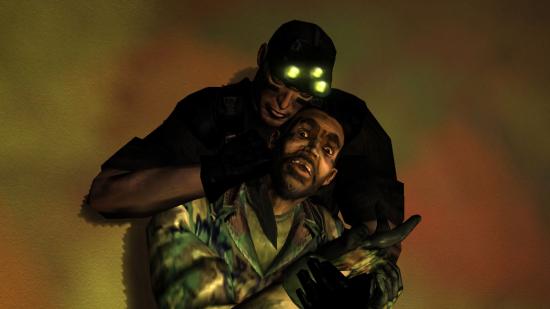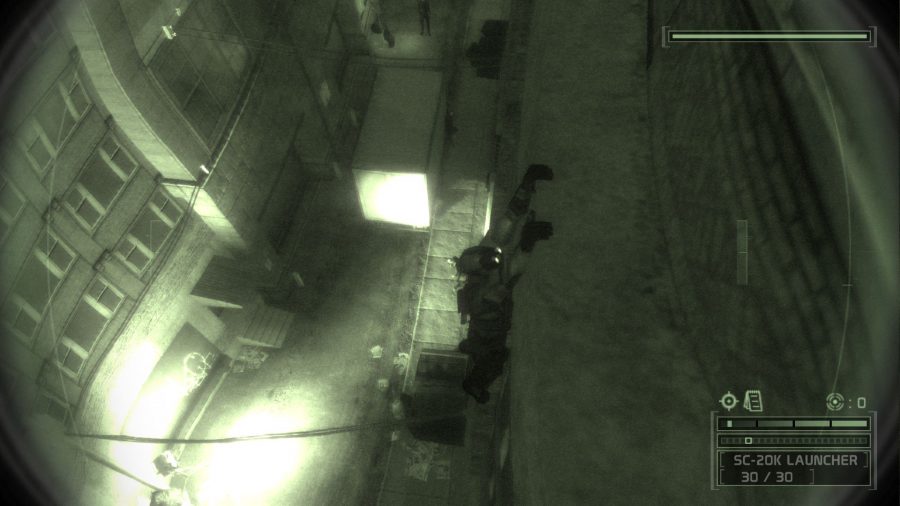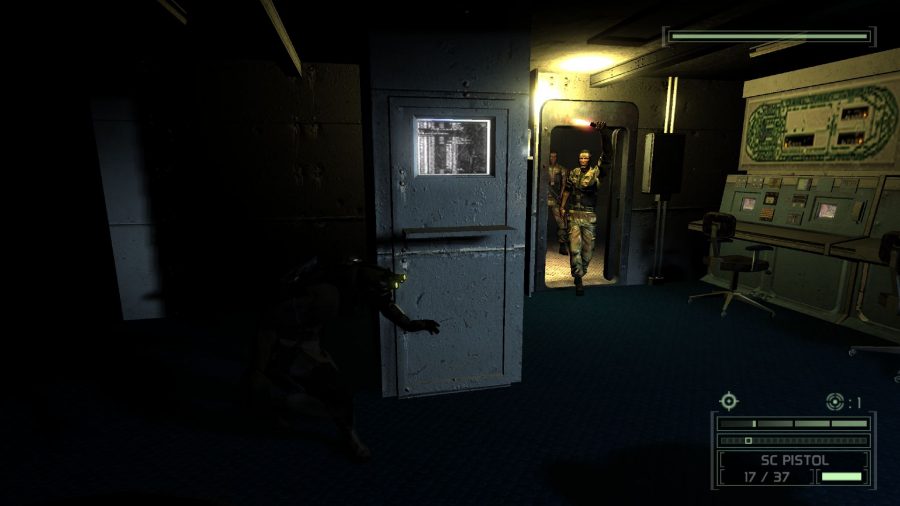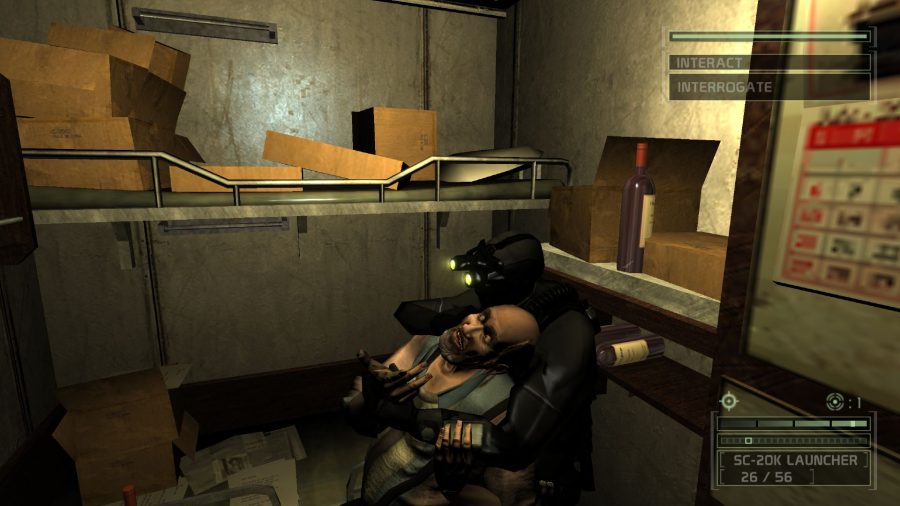In Chaos Theory, the third and arguably the best Splinter Cell game, there’s a moment that’s always stuck with me. I’m upside-down, shimmying along a pipe on the ceiling to cross over a fire that’s burning below, like a very trim spit-roast hog dressed in jet black neoprene. When I’m about halfway along the pipe, a goon pokes his head through the doorway ahead of me; in a two-second storm of sheer instinct, I let go of the pipe with my hands, hanging completely upside-down by my legs, draw my silenced pistol, take a single shot – plip – and the man crumples into a pile before me.
What makes this Mission: Impossible moment memorable is its rarity in a game that’s about 90% pure stealth. Sam Fisher has an impressive array of acrobatic skills, like the aforementioned upside-down shot, a split-jump that lets him straddle narrow corridors, and the ability to grab enemies while hanging from the ceiling like a Half-Life barnacle, but they feel special because he so rarely gets to actually use them. Fisher is constantly showing off his gymnast skillset in later Splinter Cell outings.
Chaos Theory came right at the end of a golden era of stealth games; one that more or less began with Thief: The Dark Project in 1998 and probably ended around 2006 with Hitman: Blood Money. Released in 2005, Chaos Theory was the last Splinter Cell game left untouched by the emerging trend towards action and explosions. Its combat is deliberately awkward; you have very little health, you can’t run and gun, and you have to press a button to aim before firing.
Despite being the first game in the series to open up missions into less linear stealth sandboxes, Chaos Theory still has several scripted or semi-scripted moments like the one I described earlier in each mission. Whichever path you take through a mission, there’s some unique scenario to give you the occasional release from the game’s wonderful loop of tension; be it exploding some barrels to wipe out a team of guards, upside-down choking an enemy, or skittering into a vent just as a squad of enemies enters the room.
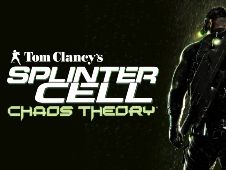 Tom Clancy’s Splinter Cell Chaos Theory Tom Clancy’s Splinter Cell Chaos Theory $9.99 $8.91 Buy now Network N earns affiliate commission from qualifying sales.
Tom Clancy’s Splinter Cell Chaos Theory Tom Clancy’s Splinter Cell Chaos Theory $9.99 $8.91 Buy now Network N earns affiliate commission from qualifying sales.
These moments wouldn’t shine if they weren’t enveloped in stealth systems that still seem advanced today. There are no markers above enemy heads to indicate alertness, no vision cones, nor x-ray vision so you can see through walls. Instead, you have a light meter showing how hidden you are, and a sound meter that tells you not just how loud you’re being, but how loud you are in relation to the ambient sound in the environment.
Many of Chaos Theory’s smartest features are hidden, working from the shadows like its hero. You might never notice, for instance, that if enemies see an object thrown to distract them, they head in the direction the object came from rather than homing in on where it landed like idiots; or that every light source, from streetlights to the red, on-off glow of a bomb, illuminates you and potentially gives your position away.
Its UI is stripped back, but there’s tons of complexity beneath the surface. It’s pretty much the opposite of Ubisoft’s contemporary formula, which is built around making games as frictionless and approachable as possible – that’s a good thing, but let’s have the option to customise it and cut away some of the extra prompts in the interest of faithfully reviving one of the stealth greats.
Assassin’s Creed and Far Cry still dabble in stealth, but these elements have been watered down over the years, with both series’ identities moving towards action-oriented combat. You need only look at the trailers for Far Cry 6 and Assassin’s Creed: Valhalla, with their explosions and epic battles, to see how Ubisoft wants to frame these games in the popular imagination.
You could instead point to the likes of Dishonored and Hitman as examples of great modern triple-A stealth games, but these thrive more in experimentation and freedom of approach – within which strictly going unseen is just one of many options.
There’s a wariness among publishers to make pure stealth games – ones that eschew the trappings of action-adventure games, and instead submerge the player in a bath of shadows where the spectrums of sound and light are affected by a thousand little variables.
Since Chaos Theory, even Splinter Cell itself gave in to the ‘play it your way’ creep, introducing concepts and abilities like ‘Aggressive Stealth’, parkour, and persistent enemy markers throughout subsequent entries. These were all features you could slap on an advert or the back of a box, whereas Chaos Theory’s greatest strengths were less marketable, but much more of a technical accomplishment.
Despite their easily identifiable Tom Clancy techno-thriller stylings, the early years of Splinter Cell were unique, singular in their commitment to stealth. But ‘unique’ isn’t really what Ubisoft shoots for these days, and the studio will need to unlearn years of excessive feature creep and formulaic design to rediscover the things that made those games special.
There’s a lot of potential in a new Splinter Cell; it could be the first time that a game utilises ray-tracing for an actual gameplay purpose, dynamically affecting Fisher’s visibility through light bouncing off surfaces, reflections, and so on. But most of the knowledge to create a sublime stealth experience is right there in the series’ deep past. Ubisoft just needs to be brave enough to dig it up.
 Tom Clancy’s Splinter Cell Chaos Theory Tom Clancy’s Splinter Cell Chaos Theory $9.99 $8.91 Buy now Network N earns affiliate commission from qualifying sales.
Tom Clancy’s Splinter Cell Chaos Theory Tom Clancy’s Splinter Cell Chaos Theory $9.99 $8.91 Buy now Network N earns affiliate commission from qualifying sales.
